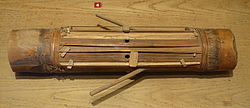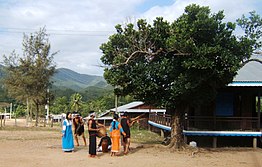Raglai people
Contributors to Wikimedia projects
 Article Images
Article Images
The Raglai (Vietnamese pronunciation: [rā ɣlāːj]) people are a Chamic ethnic group mainly living in Khánh Hòa and Ninh Thuận provinces of Central Vietnam. They speak Roglai - a Malayo-Polynesian language. The word Raglai means Forest in their language. The Raglai's population was 146,613 in 2019.[2]
 Chapi - one-string zither of Raglai - Vietnam Museum of Ethnology - Hanoi | |
| Total population | |
|---|---|
| Regions with significant populations | |
| Khánh Hòa, Bình Thuận, Ninh Thuận | |
| Languages | |
| Raglai • Vietnamese | |
| Related ethnic groups | |
| Cham people • Jarai people |

Raglai community has many names: Rànglai, Ràglai, Ràdlai, Rơglai, Ràng-chơk, Ràng-ngơk... However, these are just negative ways of "mountainous people" but no other meanings. In the Nguyễn dynasty's records, this community was once called as mọi Lá Vàng ("barbarians of yellow-leaf").
The Raglai people have lived in the high and rugged mountains in the west of Khánh Hòa, Ninh Thuận and Bình Thuận provinces, next to the Cham people in the South Central Coast plains for a very long time. The two groups of Cham and Raglai have had a deep relationship during their history. The thousand-year-old remaining proverb "Cam sa-ai Raglai adei" (Cham oldest sister, Raglai youngest sister) proved their blood relations.[3]
Previously, the Raglai community was only considered a part of the Cham people when considering the language, costumes and some customs. However, while the Cham people basically moved to the beliefs that banned idols and mascots, the Raglai over time returned to the habit of worshiping the "wooden statue" ancestors like the Central Highlands community. Since 1989, there were administrative documents and some efforts of cultural officials to go from review to the recognition of Raglai people entitled to ethnic minority regulations in 1997. Since then, Vietnamese media and entertainment have regularly read the name of this nation as Rắc-lây (Kinh language) or Raàk-lei (Rhade language).
Although Raglai people is still a small community, but it has made great contributions to modern culture in Vietnam. Even in many music competitions, Raglai contestants often win high prizes or receive huge votes from YouTube. These phenomena are often believed to come from the rich community activities of the Raglai people, which is more or less limited in the Islamic Cham people.
The Raglai people use their own specific variants of Đàn đá, Gong, Đàn nhị, Kèn bầu, Đàn bầu instruments those named as PATƠU TILẼNG, CHHAR / CHĨNG, CANHĨ, CHAPI VILUAI respectively.[4]
- Pinăng Tắc - Ama Tắc (1910 - 1987), a Việt Cộng guerrilla of Ninh Thuận Province Command, who led the Raglai people during First Indochina War and Second Indochina War, was awarded the Hero of the People's Armed Forces on May 5, 1965.[5]
- ^ "Report on Results of the 2019 Census". General Statistics Office of Vietnam. Retrieved 1 May 2020.
- ^ "Committee of Ethnic Minority Affairs - Introduction about Raglai people". cema.gov.vn. Retrieved 20 April 2022.
- ^ "The relation between Chams and Raglai peoples". dantocmiennui.vn. 22 June 2017. Retrieved 28 April 2022.
- ^ "Vietnam National Museum of History - Hero Pinăng Tắc". baotanglichsu.com. Retrieved 8 April 2022.
- ^ "The traditional musical instruments of the Raglai people". baoninhthuan.com.vn. Retrieved 26 July 2023.
- Hải Liên. 2002. Trang phục cố truyền Raglai. Hanoi: Nhà xuất bản Đại Học Quốc Gia Hà nội.
- Nguyễn Hữu Bài, et al. 2014. Văn hóa dân gian Raglai ở Khanh Hòa. Hồ Chí Minh City: Nhà xuất bản văn hóa - văn nghệ. ISBN 978-604-68-1078-0